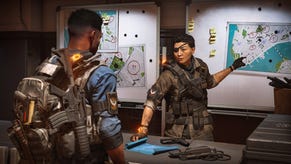If Ubisoft wants to cling on to Clancy, it's time to talk politics
By the book.
How do you duck a question about the politics of a game which pits a citizen militia against a corrupt government in modern-day Washington DC? Well, you could start by talking about the weather. "I loved the coldness of the first game, and to be able to go to DC and actually get to feel the humidity and hot summer of East Coast weather," The Division 2's creative director Terry Spiers remarked to Polygon at E3, when pressed about what it meant to stage an armed uprising in the capital of his own country. "That's what I'm most excited about."
This kind of chipper, non-committal platitude has become as natural as breathing for Ubisoft, even as its various Clancy properties bury their expensively accessorised noses in topics like the South American narcotics trade or the ethics of torture. It's all rather odd when you consider the pride, not to say enormous smugness, Tom Clancy himself took in the links between his stories and the shadow realm of superpower relations and national security. Here he is on TV in 1998, for instance, arguing for a change of law to permit the assassination of heads of state with reference to his 1996 door-stopper Executive Orders. Here he is in a memorably unsympathetic Washington Post profile, boasting of the "half-million" calls he received from admiring reporters in the aftermath of Operation Desert Storm.
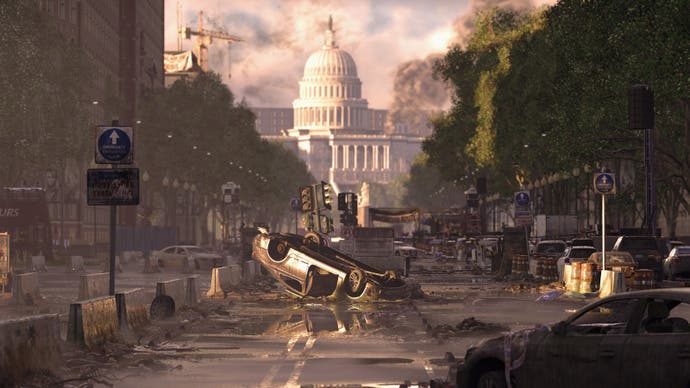
With their starchy casts of alpha nerds and special operators, visions of an America that is at once wargod and underdog and steamy accounts of missile launches and fleet manoeuvres, Clancy's books were warmly embraced by the military establishment. Colin Powell - former US secretary of state and one of the minds behind the bogus case for Saddam's secret WMDs - once declared that "a lot of what I know about warfare I learned from reading Tom". Ronald Reagan was also a fan: while negotiating with the USSR in Reykjavik, he recommended Red Storm Rising to Margaret Thatcher for its "excellent picture of the Soviet Union's intentions and strategy". Clancy, who never served in the armed forces thanks to acute near-sightedness, reveled in all this, name-dropping high rank contacts to reporters and railing against peaceniks and grifter politicians in speeches at academies and bases. You wonder what he'd have made of Ubisoft's determination to avoid seeing Tom Clancy games in any kind of context, to show us footage of democracies on fire while talking gaily of blue skies and "exploring a new city".
Clancy died in 2013 but, like H.P. Lovecraft, he is very much with us today, a cranky, long-since-rampant AI at the heart of the military-entertainment complex. Books are still written in his name, chiselled with Old Testament grandeur atop each volume while that of the surrogate author languishes below the title. There's an Amazon show on the boil starring Jack Ryan, the CIA wonk turned president who is Clancy's most famous creation. Above all, Clancy's spectre continues to haunt video games, from tactical sims like Splinter Cell and Ghost Recon to the many shooters that take inspiration from his love of spec ops jargon and high-fidelity hardware.
The man himself doesn't seem to have been much of a gamer, or at least, a video gamer, but he was among the first big figures in older media to see the benefits of moving into video games, co-founding North Carolina developer Red Storm with ex-serviceman Doug Littlejohns in 1996. Film critics often dwell on how Clancy's books spurred a reworking of the Hollywood action hero, as Bond's camp misogyny and Schwarzenegger's brawn gave way to CIA-schooled everyman leads, equipped with licensed battlefield appliances and a headful of CQC. Less harped upon is how Clancy's adoration for soldiers and their toys - together with Steven Spielberg's Medal of Honor and the emerging WW2 shooter - helped transform the 3D action game from a playful, even subversive affair composed of impossible spaces and cartoon excess into something more directed, "grounded", cinematic and clinical.
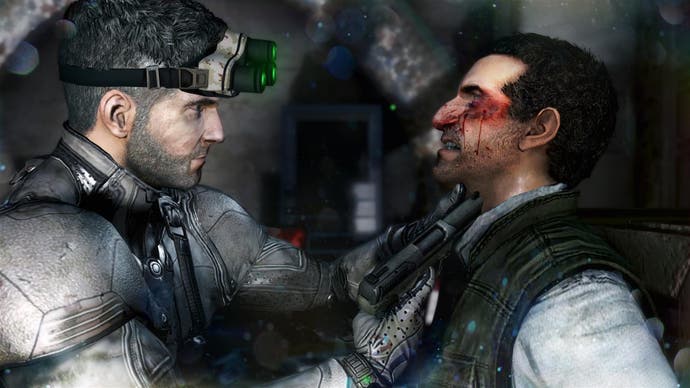
Clancy's books often read less like novels than manuals or, at their worst, advertisements. He seldom suffers a piece of lethal gimcrackery to pass by without treating you to a breakdown, be it a glimpse of a Browning automatic pistol whose "flat-black finish" suggests that it was designed for military use, or the "pounding" of plasma towards lithium compounds inside a detonating nuclear bomb. One quality all these gizmos share - hundred-feet-high Freudian overtones aside - is that they seldom fail or miss. In Red Storm Rising, battleship computers correct their aim minutely for wind speed before the first shell in a barrage has even landed. Clancy's male heroes (with a handful of exceptions, women exist in his books to be fridged, sidelined or humiliated) are no less surgical when push comes to shove, if occasionally a bit ruffled in that glib way beloved of Lucas-era Harrison Ford. They're not above moments of cornfed manly emotiveness - a beer with an old comrade, a round of golf with a superior - but in action they're robotically competent, sliding through encounters with oracular panache as the narration keeps track of every last minute observation or decision.
"Techno thriller" is the label given to all this, but I wonder whether a better one is "military procedural". As with accounts of crime scenes in detective fiction, Clancy's books are essentially about raising order from chaos, but where detective yarns celebrate the mess and dazzle of human intuition, Clancy's sleekly choreographed infiltrations, airstrikes and gunfights are homages to something vast and unlovely - the resources and reach of the US war machine, its construction and mobilisation of time and space. Every fleeting second in a Clancy action scene is indexed and paced with recourse to a beefy handbook of acronyms and call-signs, protocol and intelligence data, gadgets and go-words. It's a powerful means of interrogating a reality that is represented as incomprehensible without the machine's intervention, and to be fed through these whirring complexities was, for many of Clancy's readers, an irresistible sedative in the face of nebulous, on-going catastrophes like the Cold War. The gap between "making sense" of existence and beating it into shape is, in the military procedural, erased, and the result is a world that is ultimately just a byproduct of the technology deployed against it.
You might sum this up by saying that Clancy's books turn life into a video game, but that's to betray how much Clancy's idealised portrayals of modern combat and strategy have shaped the idea of a video game. As you'd expect, actual Clancy titles engage with them most directly and faithfully. 1998's Rainbow Six (named, in a truly majestic show of tone-deafness, for Archbishop Desmond Tutu's description of post-apartheid South Africa as a "rainbow nation") turns hostage rescue into a clockwork diorama, as you not only customise your troops but plot their movements from moment to moment, corner to corner. Ghost Recon's synchronised headshots "standardise" each level's sense of time, as operators in farflung corners coincide in the act of killing; they celebrate the war machine's ability to unify its parts across great distances, to impose a 1:1 relationship between order and execution. Clancy games have advanced (or so we are often told by their creators) in lock-step with advances in battlefield tech, their heartbeat monitors and 2D sonar displays giving way to more-or-less literal holographic flourishes that make the HUD part of the landscape. It's as though the simulation were eating the events depicted alive. In Splinter Cell: Conviction the quagmire of Western misadventure in Iraq becomes a single highway, a decorously smoking corridor in which bombed cars serve as a canvas for waypoint information.
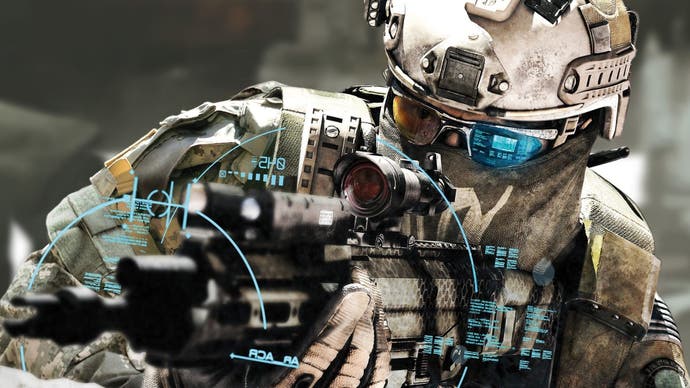
You can see flashes of the Clancy procedural in many other games, and in the language of game design. It's there in developer and consumer preoccupation with things like "seamless" level scripting or that much-hailed concept of "flow", where the player's sense of capability and difficulty are so perfectly balanced that, like Clancy's droll hitman John Clark, they act and react without the inconvenience of thought. More overtly, you can see it in the way satellite footage, drone cams and the spectacle of intelligence briefings became integral to Battlefield and Call of Duty's multiple-perspective storytelling in the early noughties. And you can see it, of course, in today's absolute glut of high-fidelity gun customisation systems, many of which serve as tacit publicity for arms manufacturers.
Clancy's lingering influence is noxious for many reasons. The obvious one is that the games touched by it risk serving as propaganda for weapons and tactics that are seldom as reliable as Clancy claims. In 1989, the former naval intelligence officer Scott Shuger wrote an excoriating takedown of the Clancyverse for the Washington Monthly, pointing to a disastrous air attack on the Gaddafi regime in 1986 as evidence that things like laser-guided munitions aren't the collateral-proof instruments of retribution they're said to be.
"One of the Navy raids was said by its commanding admiral to have delivered only 10 percent of its weapons onto its target," he wrote. "And for all the trouble our bombs had in finding targets, they had no trouble finding innocents. The raid killed 43 civilians, including several babies." Shuger also cites the death of a crewman due to imperfect submarine sonar in 1989, an incident that occurred not in combat but, absurdly enough, during filming of Clancy adaptation The Hunt for Red October. It would be nice to say that today's automated systems and indirect fire weapons are much more trustworthy. Last year's staggering quantity of civilian deaths by airstrike suggests otherwise, with 2,878 Syrian non-combatants losing their lives to coalition bombing of Raqqa alone. In buying into the myths of uber-precision woven around devices like Predator drones, video games become party, like Clancy, to an ideology of intervention whose righteousness and effectiveness are, to say the least, in question.
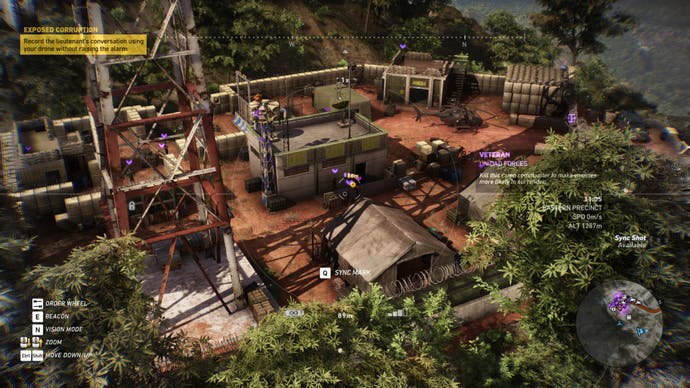
But perhaps the bigger problem with Clancy is that all we have left is his shell. Decades after Ubisoft acquired the rights to his name, the publisher and its imitators have buried the author so handily that the views that animate his fictions now slip by uninterrogated. While Clancy the man was outspoken about the political dimensions of his work, Clancy as a brand is terrified of taking a public stand on anything, even as the games themselves deal freely in the policing of rogue states and the trampling of due process in the name of the greater good. The Division franchise is an especially obstinate example of this. It poses an America saved by its citizens, "ordinary people" rising up by presidential decree to battle tyrannous feds and sociopathic have-nots. This is a play of themes dear to Clancy's staunchly reactionary heart: his books are full of "real" Americans like firefighters, cops and doctors, salt-of-the-Earth types who respect the flag, roll up their sleeves and get their hands dirty. Executive Orders concludes with Ryan forming a government with these archetypes, after the country's self-serving political classes are decimated by a terrorist attack. Ubisoft would rather not talk about the The Division's ideological underpinnings, however, and with good reason - proposing to speak on behalf of "real" people while demonising the rest is an elementary gambit of fascism.
The Tom Clancy games may draw upon the testimony of architects, firearms experts and special forces teams but they are always represented as firmly neutral, as mere entertainment, and the result is not an apolitical experience but politics by stealth. They are games that quietly advocate hawkish attitudes and philosophies while trying to lose the player in their lethal machinery, in the smooth interlocking of components and command structures. Ubisoft's pretence of inconsequence could be its most detestable quality, as a publisher - you might as well talk about landmines as though they grew from the soil of their own accord - and sadly undervalues the artistry and relevance of the worlds that have flourished under its banner. I have little sympathy for Clancy's convictions, but for all his dribbling over fuel rods and heat-seekers, parades of grinning Good Guys and contagious daydreams of America in crisis, at least he didn't claim his work had nothing to do with the society that gave rise to it. At least he embraced the role of the fiction-maker as an interpreter of the times, as political weathervane rather than pure fantasist.


